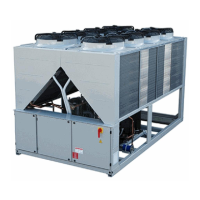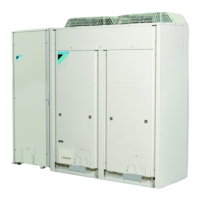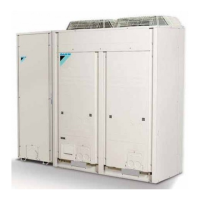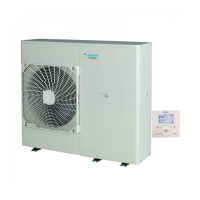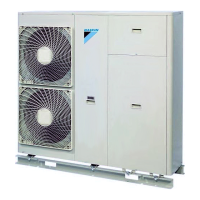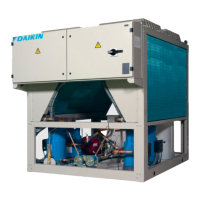D-EIMAC00801-17EN-AR - 11/44
obstacles, there could be a combination of warm air
recirculation and/or insufficient supply to the air-cooled
condenser which could cause a reduction of capacity and
efficiency.
In any case, the microprocessor will allow the unit to adapt
itself to new operating conditions and deliver the maximum
available capacity under any given circumstances, even if the
lateral distance is lower than recommended, unless the
operating conditions should affect personel safety or unit
reliability.
When two or more units are positioned side by side, a distance
of at least (see Figure 4G or 4H) between condenser banks is
recommended.
The minimum distances ensure functionality of the chiller in
most applications. However, there are specific situations which
include multiple chiller installations: in this case the following
recommendations are to be followed:
Multiple chiller installed side by side in a free field with
dominant wind.
Considering an installation in areas with a dominant wind from
a specific direction (as shown in the Fig.5):
Chiller N°1: is performing normally without any
ambient over-temperature
Chiller N° 2: is working in a warmed ambient. The
first circuit (from the left) is working with air
recirculating from Chiller 1 and the second circuit to
the recirculating air from the chiller N°1 and
recirculation from itself.
Chiller N° 3: circuit on the left is working in a over-
temperature ambient due to the recirculating air from
the other two chillers, circuit on the right is working
quite normally.
In order to avoid the hot air recirculation due to dominant
winds, the installation where all chillers are aligned to the
dominant wind is preferred (see figure below).
Multiple chiller installed side by side in a compound.
In case of compounds with walls of the same height of the
chillers or higher, the installation is not recommended. Chiller 2
and chiller 3 work with sensible higher temperature due to the
enhanced recirculation. In this case special precautions must
be taken in to account according to the specific installation (eg:
louvered walls, install the unit on base frame in order to
increase the height, ducts on the discharge of the fans, high lift
fans, etc).
All the above cases are even more sensitive in case of design
conditions close to the limits of the unit operating envelope.
NOTE: Daikin cannot be considered responsible in case of
malfunctions generated by hot air recirculation or insufficient
airflow as result of improper installation if the above
recommendations are ignored.
For further solutions, please consult manufacturer
representative.
Sound protection
When sound levels require special control, great care must be
exercised to isolate the unit from its base by appropriately
applying anti-vibration elements (supplied as an option).
Flexible joints must be installed on the water connections, as
well.
Water piping
Piping must be designed with the lowest number of elbows
and the lowest number of vertical changes of direction. In this
way, installation costs are reduced considerably and system
performance is improved.
The water system must have:
1. Anti-vibration mountings in order to reduce
transmission of vibrations to the structures.
2. Isolating valves to isolate the unit from the water
system during service.
3. Manual or automatic air venting device at the
system’s highest point.; drain device at the system’s
lowest point.
4. Neither the evaporator nor the heat recovery device
must be positioned at the system’s highest point.
5. A suitable device that can maintain the water system
under pressure (expansion tank, etc.).
6. Water temperature and pressure indicators to assist
the operator during service and maintenance.
Figure 4 - Minimum clearance requirements

